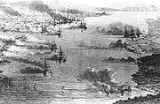
Bombardment of Kagoshima
Encyclopedia
The Bombardment of Kagoshima, also known as the , took place on 15–17 August 1863 during the Late Tokugawa shogunate
. The British Royal Navy
was fired on from the coastal batteries near town of Kagoshima and in retaliation bombarded the town. The British were trying to exact a payment from the daimyo
of Satsuma
following the Namamugi Incident
of 1862, in which British nationals were attacked (one killed, two wounded) by Satsuma samurai
for not showing the proper respect for a daimyo (Shimazu Hisamitsu
).
on September 14, 1862, Lieutenant-Colonel Neale, the British Chargé d'Affaires, demanded from the bakufu an apology and a huge indemnity for the Namamugi outrage of £100,000 ($440,000 in Mexican silver dollars), representing roughly 1/3 of the total revenues of the Bakufu for one year. Neale kept threatening a naval bombardment of Edo
if the payment was not made. Britain also demanded of the Satsuma domain the arrest and trial of the perpetrators of the outrage, and £25,000 compensation for the surviving victims and the relatives of Charles Lennox Richardson
.
The Bakufu (Japanese central government), led by Ogasawara Nagamichi
in the absence of the Shogun who was in Kyoto
, eager to avoid trouble with European powers, negotiated with France and Great Britain on July 2, 1863, on board the French warship Sémiramis, apologized and paid the indemnity to the British authorities. Participating in the settlement were the main French and British political and navy representatives of the time: Duchesne de Bellecourt the French Minister in Japan, Lieutenant-Colonel Neale the Chargé d'affaires of Great Britain, Admiral Jaurès
and Admiral Kuper
.
Satsuma Province
however refused to apologize, to pay the compensation of 25,000 pounds demanded by the British, or to convict and execute the two Japanese samurai responsible for the murder, arguing that disrespect to the Daimyō was normally sanctioned by the immediate death of those showing disrespect. Legally, their claim was invalid in this case, as foreigners in Japan benefited from extraterritoriality
due to Japan's reluctant acceptance of what the Japanese called the Unequal treaties
with Europe. Japanese customary law did not apply to foreigners. Furthermore, politically, Satsuma could not be seen as submitting to European demands in the very anti-colonial context at that time in Japan.
Great Britain, however, wished to make a point against anti-foreign outrages in Japan. Other anti-foreign troubles were occurring throughout the country at the same time, reinforced by Emperor Kōmei
's 1863 "Order to expel barbarians
". The European powers chose to react militarily to such exactions: the straits of Shimonoseki had already seen attacks on American, Dutch and French ships passing through, each of which had brought retaliation from those countries, with the U.S. frigate USS Wyoming
under Captain McDougal, the Dutch warship Medusa under Kapitein de Casembroot, and the two French warships Tancrède and the Dupleix
under Captain Benjamin Jaurès
attacking the mainland. Eventually, on 14 August 1863, a multinational fleet under Admiral Kuper and the Royal Navy commenced the Bombardment of Shimonoseki
to prevent further attacks on western shipping there. They succeeded.
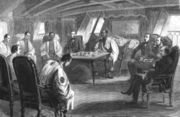
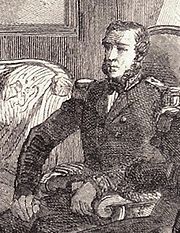
On the 5th, a Vice-Minister from Edo visited Colonel Neale, but far from further opposing the expedition actually transmitted that the Shogunate intended to send one of its steamers with the squadron. The steamer in question however did not join the expedition.
(with Colonel Neale onboard), HMS Pearl
, HMS Perseus, HMS Argus, HMS Coquette
, HMS Racehorse
and the gunboat HMS Havoc. They sailed for Kagoshima and anchored in the deep waters of Kinko Bay on August 11, 1863. Satsuma envoys came aboard Euryalus and letters were exchanged, with the British commander pressing for a resolution satisfactory to his demands within 24 hours. The Satsuma clan prevaricated, refusing to comply for various reasons.

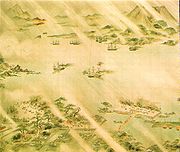

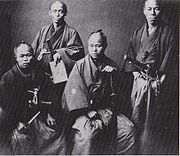
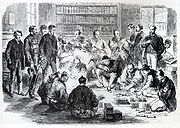 The deadline expired, and diplomacy gave way to coercion. Deciding to put pressure on Satsuma, the British Navy commander seized three foreign-built steam merchant ships (Sir George Grey, Contest, England, with an aggregate value of about $300,000/₤200,000 sterling or GB£
The deadline expired, and diplomacy gave way to coercion. Deciding to put pressure on Satsuma, the British Navy commander seized three foreign-built steam merchant ships (Sir George Grey, Contest, England, with an aggregate value of about $300,000/₤200,000 sterling or GB£
128,000,000 in 2011 pounds) belonging to Satsuma which were at anchor in Kagoshima harbour, to use them as a bargaining tool. Picking their moment, just as a typhoon started, the Satsuma forces on shore vented their anger by firing their round shot
cannons at the British ships. Surprised by the hostility, the British fleet responded by first pillaging and then setting on fire the three captured steamships (to the chagrin of the British sailors, who were thereby deprived of prize money
). Then, after nearly two hours getting ready (they had not expected or intended to get into any exchange of fire with Satsuma), a line of battle was formed, which sailed along the coast of Kagoshima and fired cannon shells
and round shot. One of the British warships, the gunboat Havoc, set five Ryukuan trading junk
s on fire.
 The naval bombardment claimed just five lives among the people of Satsuma
The naval bombardment claimed just five lives among the people of Satsuma
(the city had been evacuated in anticipation of the conflict), and 13 lives among the British (including Captain Josling of the British flagship Euryalus
, and his second-in-command Commander Wilmot, both decapitated by the same cannonball). Material losses were considerable, with around 500 wood-and-paper houses burnt in Kagoshima (about 5% of Kagoshima's urban area), and the three Satsuma steamships and five junks destroyed. The encounter was face-saving for Satsuma, and was even claimed as a victory by the Japanese side, considering the relative number of casualties. The British ships did not land troops or seize cannons (which would have signalled the absolute defeat of Satsuma), Kuper having decided that enough was enough.
The conflict actually became the starting point of a close relationship between Satsuma and Britain, which became major allies in the ensuing Boshin War
. From the start, the Satsuma Province
had generally been in favour of the opening and modernization of Japan. Although the Namamugi Incident was unfortunate, it was not characteristic of Satsuma's policy, and was rather abusively branded as an example of anti-foreign sonnō jōi
sentiment, as a justification to a strong European show of force.
An interesting historical footnote to this incident was that a young Heihachiro Togo was manning one of the cannons used to defend the port, and is reported to have attributed his future career as head and 'father' of the Imperial Japanese Navy
to this moment.
Late Tokugawa shogunate
, literally "end of the curtain", are the final years of the Edo period when the Tokugawa shogunate came to an end. It is characterized by major events occurring between 1853 and 1867 during which Japan ended its isolationist foreign policy known as sakoku and transitioned from a feudal shogunate...
. The British Royal Navy
Royal Navy
The Royal Navy is the naval warfare service branch of the British Armed Forces. Founded in the 16th century, it is the oldest service branch and is known as the Senior Service...
was fired on from the coastal batteries near town of Kagoshima and in retaliation bombarded the town. The British were trying to exact a payment from the daimyo
Daimyo
is a generic term referring to the powerful territorial lords in pre-modern Japan who ruled most of the country from their vast, hereditary land holdings...
of Satsuma
Satsuma
Satsuma may refer to:* Satsuma , a citrus fruit* Satsuma , a genus of land snails-In Japan:* Satsuma, Kagoshima, a Japanese town* Satsuma District, Kagoshima, a district in Kagoshima Prefecture...
following the Namamugi Incident
Namamugi Incident
The was a samurai assault on foreign nationals in Japan on September 14, 1862, which resulted in the August 1863 bombardment of Kagoshima, during the Late Tokugawa shogunate...
of 1862, in which British nationals were attacked (one killed, two wounded) by Satsuma samurai
Samurai
is the term for the military nobility of pre-industrial Japan. According to translator William Scott Wilson: "In Chinese, the character 侍 was originally a verb meaning to wait upon or accompany a person in the upper ranks of society, and this is also true of the original term in Japanese, saburau...
for not showing the proper respect for a daimyo (Shimazu Hisamitsu
Shimazu Hisamitsu
Prince , also known as ', was a Japanese samurai of the late Edo period. The younger brother of Shimazu Nariakira, Hisamitsu served as regent for his underage son Tadayoshi , who became the 12th and last lord. Hisamitsu was instrumental in the efforts of the southern Satsuma, Chōshū, and Tosa clans...
).
Background
Following the Namamugi IncidentNamamugi Incident
The was a samurai assault on foreign nationals in Japan on September 14, 1862, which resulted in the August 1863 bombardment of Kagoshima, during the Late Tokugawa shogunate...
on September 14, 1862, Lieutenant-Colonel Neale, the British Chargé d'Affaires, demanded from the bakufu an apology and a huge indemnity for the Namamugi outrage of £100,000 ($440,000 in Mexican silver dollars), representing roughly 1/3 of the total revenues of the Bakufu for one year. Neale kept threatening a naval bombardment of Edo
Edo
, also romanized as Yedo or Yeddo, is the former name of the Japanese capital Tokyo, and was the seat of power for the Tokugawa shogunate which ruled Japan from 1603 to 1868...
if the payment was not made. Britain also demanded of the Satsuma domain the arrest and trial of the perpetrators of the outrage, and £25,000 compensation for the surviving victims and the relatives of Charles Lennox Richardson
Charles Lennox Richardson
Charles Lennox Richardson was an English merchant based in Shanghai who was killed in Japan during the Namamugi Incident. His name is properly spelled as “Charles Lenox Richardson” according to the census and family documents.-Merchant:Richardson was born in London in 1834. He relocated to...
.
The Bakufu (Japanese central government), led by Ogasawara Nagamichi
Ogasawara Nagamichi
was the a Japanese samurai and official in the Bakumatsu period Tokugawa Shogunate. Before the Meiji Restoration, his courtesy title was Iki no Kami and lower 5th Court rank.-Biography:...
in the absence of the Shogun who was in Kyoto
Kyoto
is a city in the central part of the island of Honshū, Japan. It has a population close to 1.5 million. Formerly the imperial capital of Japan, it is now the capital of Kyoto Prefecture, as well as a major part of the Osaka-Kobe-Kyoto metropolitan area.-History:...
, eager to avoid trouble with European powers, negotiated with France and Great Britain on July 2, 1863, on board the French warship Sémiramis, apologized and paid the indemnity to the British authorities. Participating in the settlement were the main French and British political and navy representatives of the time: Duchesne de Bellecourt the French Minister in Japan, Lieutenant-Colonel Neale the Chargé d'affaires of Great Britain, Admiral Jaurès
Benjamin Jaurès
Constant Louis Jean Benjamin Jaurès was a 19th-century French Admiral and Senator, who was active in Japan during the Bombardment of Shimonoseki and the Boshin war ....
and Admiral Kuper
Augustus Leopold Kuper
Admiral Sir Augustus Leopold Kuper GCB was a Royal Navy officer known for his commands in the far east.-Naval career:...
.
Satsuma Province
Satsuma Province
was an old province of Japan that is now the western half of Kagoshima Prefecture on the island of Kyūshū. Its abbreviation is Sasshū .During the Sengoku Period, Satsuma was a fief of the Shimazu daimyo, who ruled much of southern Kyūshū from their castle at Kagoshima city.In 1871, with the...
however refused to apologize, to pay the compensation of 25,000 pounds demanded by the British, or to convict and execute the two Japanese samurai responsible for the murder, arguing that disrespect to the Daimyō was normally sanctioned by the immediate death of those showing disrespect. Legally, their claim was invalid in this case, as foreigners in Japan benefited from extraterritoriality
Extraterritoriality
Extraterritoriality is the state of being exempt from the jurisdiction of local law, usually as the result of diplomatic negotiations. Extraterritoriality can also be applied to physical places, such as military bases of foreign countries, or offices of the United Nations...
due to Japan's reluctant acceptance of what the Japanese called the Unequal treaties
Unequal Treaties
“Unequal treaty” is a term used in specific reference to a number of treaties imposed by Western powers, during the 19th and early 20th centuries, on Qing Dynasty China and late Tokugawa Japan...
with Europe. Japanese customary law did not apply to foreigners. Furthermore, politically, Satsuma could not be seen as submitting to European demands in the very anti-colonial context at that time in Japan.
Great Britain, however, wished to make a point against anti-foreign outrages in Japan. Other anti-foreign troubles were occurring throughout the country at the same time, reinforced by Emperor Kōmei
Emperor Komei
was the 121st emperor of Japan, according to the traditional order of succession. Kōmei's reign spanned the years from 1846 through 1867.-Genealogy:Before Kōmei's accession to the Chrysanthemum Throne, his personal name was ;, his title was ....
's 1863 "Order to expel barbarians
Order to expel barbarians
The was an edict issued by the Japanese Emperor Kōmei in 1863 against the Westernization of Japan following the opening of the country by Commodore Perry in 1854.-The order:...
". The European powers chose to react militarily to such exactions: the straits of Shimonoseki had already seen attacks on American, Dutch and French ships passing through, each of which had brought retaliation from those countries, with the U.S. frigate USS Wyoming
USS Wyoming (1859)
The first USS Wyoming of the United States Navy was a wooden-hulled screw sloop that fought on the Union side during the American Civil War. Sent to the Pacific Ocean to search for the CSS Alabama, Wyoming eventually came upon the shores of Japan and engaged Japanese land and sea forces...
under Captain McDougal, the Dutch warship Medusa under Kapitein de Casembroot, and the two French warships Tancrède and the Dupleix
FS Dupleix (1861)
The Dupleix was a steam and sail corvette of the French Marine Nationale. She was the first French vessel named after the 18th Century Governor of Pondichéry and Gouverneur Général of the French possessions in India marquess Joseph François Dupleix.After her commissioning, the Dupleix was sent to...
under Captain Benjamin Jaurès
Benjamin Jaurès
Constant Louis Jean Benjamin Jaurès was a 19th-century French Admiral and Senator, who was active in Japan during the Bombardment of Shimonoseki and the Boshin war ....
attacking the mainland. Eventually, on 14 August 1863, a multinational fleet under Admiral Kuper and the Royal Navy commenced the Bombardment of Shimonoseki
Bombardment of Shimonoseki
The Battles for Shimonoseki refers to a series of military engagements in 1863 and 1864, fought to control Shimonoseki Straits by joint naval forces from the Great Britain, France, the Netherlands and the United States, against the Japanese feudal domain of Chōshū, which took place off and on the...
to prevent further attacks on western shipping there. They succeeded.


Protestations of the Bakufu
Following protracted and fruitless negotiations with Satsuma that had taken over a year, the British Chargé d'affaires eventually had had enough. Under British Government instructions, he required the Royal Naval Commander-in-Chief of the Far East and China Station to coerce Satsuma into complying with the British Government's demands. Informed of the plans, the Bakufu asked for a delay in its implementation:On the 5th, a Vice-Minister from Edo visited Colonel Neale, but far from further opposing the expedition actually transmitted that the Shogunate intended to send one of its steamers with the squadron. The steamer in question however did not join the expedition.
Departure
The British squadron left Yokohama on August 6. It was composed of the flagship HMS EuryalusHMS Euryalus (1853)
HMS Euryalus was a fourth-rate wooden-hulled screw frigate of the Royal Navy, with a 400HP steam engine that could make over 12 knots. She was launched at Chatham in 1853, was 212 feet long, displaced 3125 tons and had a complement of 515...
(with Colonel Neale onboard), HMS Pearl
HMS Pearl (1855)
HMS Pearl was a Pearl-class 21-gun screw corvette of the Royal Navy launched in 1855, displacing 2187 tons.175 of the ship's crew were formed into Pearls Naval Brigade in September 1857 during the Indian Rebellion of 1857. The small force, armed largely with rifles, took part in several actions...
, HMS Perseus, HMS Argus, HMS Coquette
HMS Coquette
Six ships of the Royal Navy have borne the name HMS Coquette. A seventh was ordered but never completed: was a 28-gun sixth rate captured from the French in 1783 and in service in 1785. was a 20-gun sixth rate launched in 1807 and sold in 1817....
, HMS Racehorse
HMS Racehorse
Ten ships of the Royal Navy have borne the name HMS Racehorse:*HMS Racehorse was an 8-gun privateer captured from the French in 1757. She was on Arctic discovery in 1773. Captured by the American Andrea Doria in 1776 and destroyed by the Royal Navy in 1777 at Delaware Bay.*HMS Racehorse was a...
and the gunboat HMS Havoc. They sailed for Kagoshima and anchored in the deep waters of Kinko Bay on August 11, 1863. Satsuma envoys came aboard Euryalus and letters were exchanged, with the British commander pressing for a resolution satisfactory to his demands within 24 hours. The Satsuma clan prevaricated, refusing to comply for various reasons.
Combat





Pound sterling
The pound sterling , commonly called the pound, is the official currency of the United Kingdom, its Crown Dependencies and the British Overseas Territories of South Georgia and the South Sandwich Islands, British Antarctic Territory and Tristan da Cunha. It is subdivided into 100 pence...
128,000,000 in 2011 pounds) belonging to Satsuma which were at anchor in Kagoshima harbour, to use them as a bargaining tool. Picking their moment, just as a typhoon started, the Satsuma forces on shore vented their anger by firing their round shot
Round shot
Round shot is a solid projectile without explosive charge, fired from a cannon. As the name implies, round shot is spherical; its diameter is slightly less than the bore of the gun it is fired from.Round shot was made in early times from dressed stone, but by the 17th century, from iron...
cannons at the British ships. Surprised by the hostility, the British fleet responded by first pillaging and then setting on fire the three captured steamships (to the chagrin of the British sailors, who were thereby deprived of prize money
Prize money
Prize money has a distinct meaning in warfare, especially naval warfare, where it was a monetary reward paid out to the crew of a ship for capturing an enemy vessel...
). Then, after nearly two hours getting ready (they had not expected or intended to get into any exchange of fire with Satsuma), a line of battle was formed, which sailed along the coast of Kagoshima and fired cannon shells
Shell (projectile)
A shell is a payload-carrying projectile, which, as opposed to shot, contains an explosive or other filling, though modern usage sometimes includes large solid projectiles properly termed shot . Solid shot may contain a pyrotechnic compound if a tracer or spotting charge is used...
and round shot. One of the British warships, the gunboat Havoc, set five Ryukuan trading junk
Junk (ship)
A junk is an ancient Chinese sailing vessel design still in use today. Junks were developed during the Han Dynasty and were used as sea-going vessels as early as the 2nd century AD. They evolved in the later dynasties, and were used throughout Asia for extensive ocean voyages...
s on fire.

Satsuma Province
was an old province of Japan that is now the western half of Kagoshima Prefecture on the island of Kyūshū. Its abbreviation is Sasshū .During the Sengoku Period, Satsuma was a fief of the Shimazu daimyo, who ruled much of southern Kyūshū from their castle at Kagoshima city.In 1871, with the...
(the city had been evacuated in anticipation of the conflict), and 13 lives among the British (including Captain Josling of the British flagship Euryalus
HMS Euryalus (1853)
HMS Euryalus was a fourth-rate wooden-hulled screw frigate of the Royal Navy, with a 400HP steam engine that could make over 12 knots. She was launched at Chatham in 1853, was 212 feet long, displaced 3125 tons and had a complement of 515...
, and his second-in-command Commander Wilmot, both decapitated by the same cannonball). Material losses were considerable, with around 500 wood-and-paper houses burnt in Kagoshima (about 5% of Kagoshima's urban area), and the three Satsuma steamships and five junks destroyed. The encounter was face-saving for Satsuma, and was even claimed as a victory by the Japanese side, considering the relative number of casualties. The British ships did not land troops or seize cannons (which would have signalled the absolute defeat of Satsuma), Kuper having decided that enough was enough.
Final negotiations and convergence
Satsuma however later negotiated and paid ₤25,000 (which they borrowed from the bakufu and never repaid, due to the fall of the bakufu in 1869 and its replacement by the Meiji administration). They never produced or identified Richardson's killers, but despite this, the reparation received was enough to obtain an agreement by Britain to supply steam warships to Satsuma.The conflict actually became the starting point of a close relationship between Satsuma and Britain, which became major allies in the ensuing Boshin War
Boshin War
The was a civil war in Japan, fought from 1868 to 1869 between forces of the ruling Tokugawa shogunate and those seeking to return political power to the imperial court....
. From the start, the Satsuma Province
Satsuma Province
was an old province of Japan that is now the western half of Kagoshima Prefecture on the island of Kyūshū. Its abbreviation is Sasshū .During the Sengoku Period, Satsuma was a fief of the Shimazu daimyo, who ruled much of southern Kyūshū from their castle at Kagoshima city.In 1871, with the...
had generally been in favour of the opening and modernization of Japan. Although the Namamugi Incident was unfortunate, it was not characteristic of Satsuma's policy, and was rather abusively branded as an example of anti-foreign sonnō jōi
Sonno joi
is a Japanese political philosophy and a social movement derived from Neo-Confucianism; it became a political slogan in the 1850s and 1860s in the movement to overthrow the Tokugawa bakufu, during the Bakumatsu period.-Origin:...
sentiment, as a justification to a strong European show of force.
An interesting historical footnote to this incident was that a young Heihachiro Togo was manning one of the cannons used to defend the port, and is reported to have attributed his future career as head and 'father' of the Imperial Japanese Navy
Imperial Japanese Navy
The Imperial Japanese Navy was the navy of the Empire of Japan from 1869 until 1947, when it was dissolved following Japan's constitutional renunciation of the use of force as a means of settling international disputes...
to this moment.
See also
- Anglo-Japanese relationsAnglo-Japanese relationsThe history of the relationship between Britain and Japan began in 1600 with the arrival of William Adams on the shores of Kyūshū at Usuki in Ōita Prefecture...
- Bombardment of ShimonosekiBombardment of ShimonosekiThe Battles for Shimonoseki refers to a series of military engagements in 1863 and 1864, fought to control Shimonoseki Straits by joint naval forces from the Great Britain, France, the Netherlands and the United States, against the Japanese feudal domain of Chōshū, which took place off and on the...
- Ishibashi ParkIshibashi Parkis a park in Hamachō, Kagoshima, Japan. At the end of the Edo period , local lord Shimazu Shigehide had five bridges, collectively called the Gosekkyō , built across the Kōtsuki River. Two of them collapsed in floods in 1993. The remaining three were moved to a new location and restored...
- Satsuma clan
- Satsuma Domain

